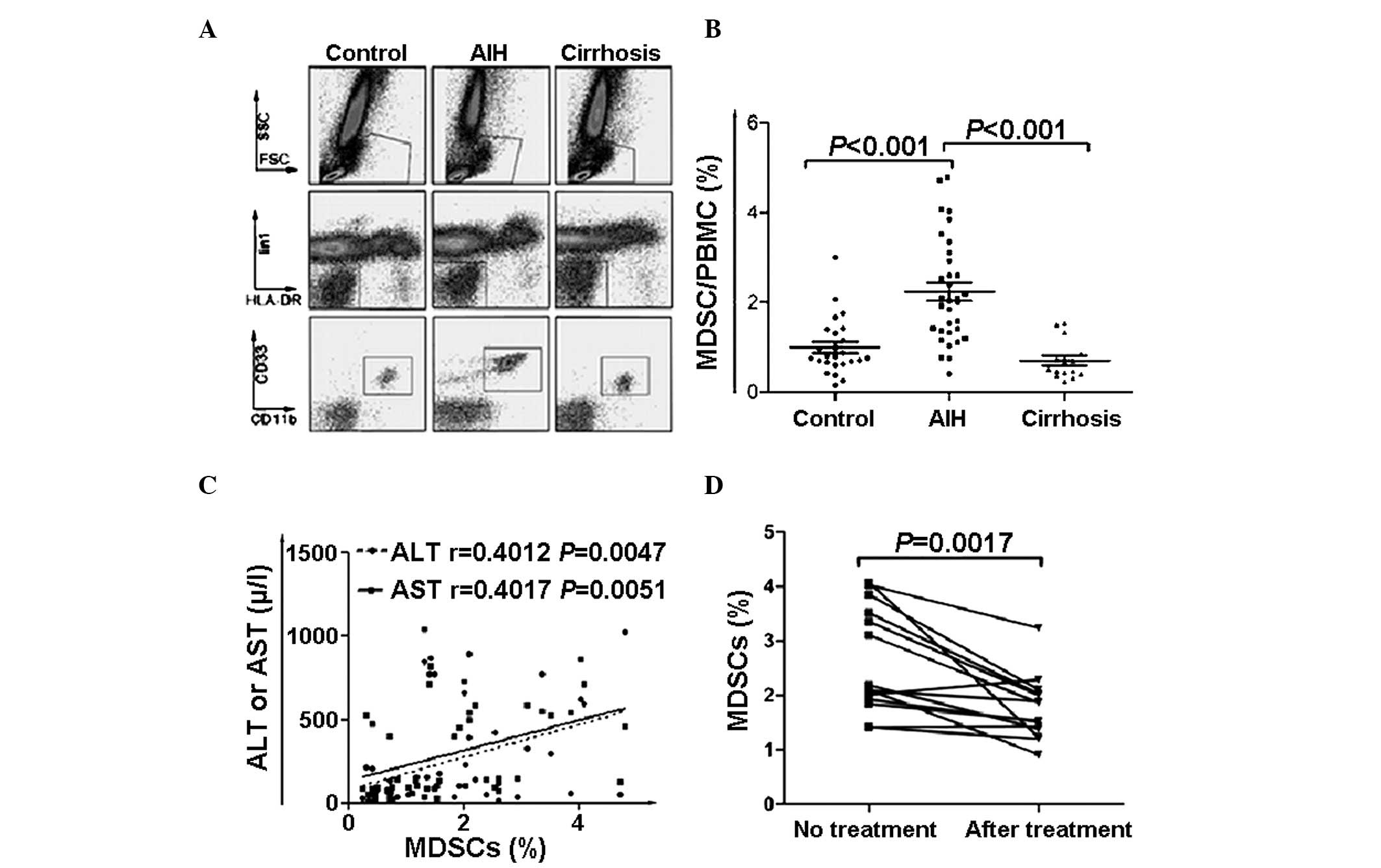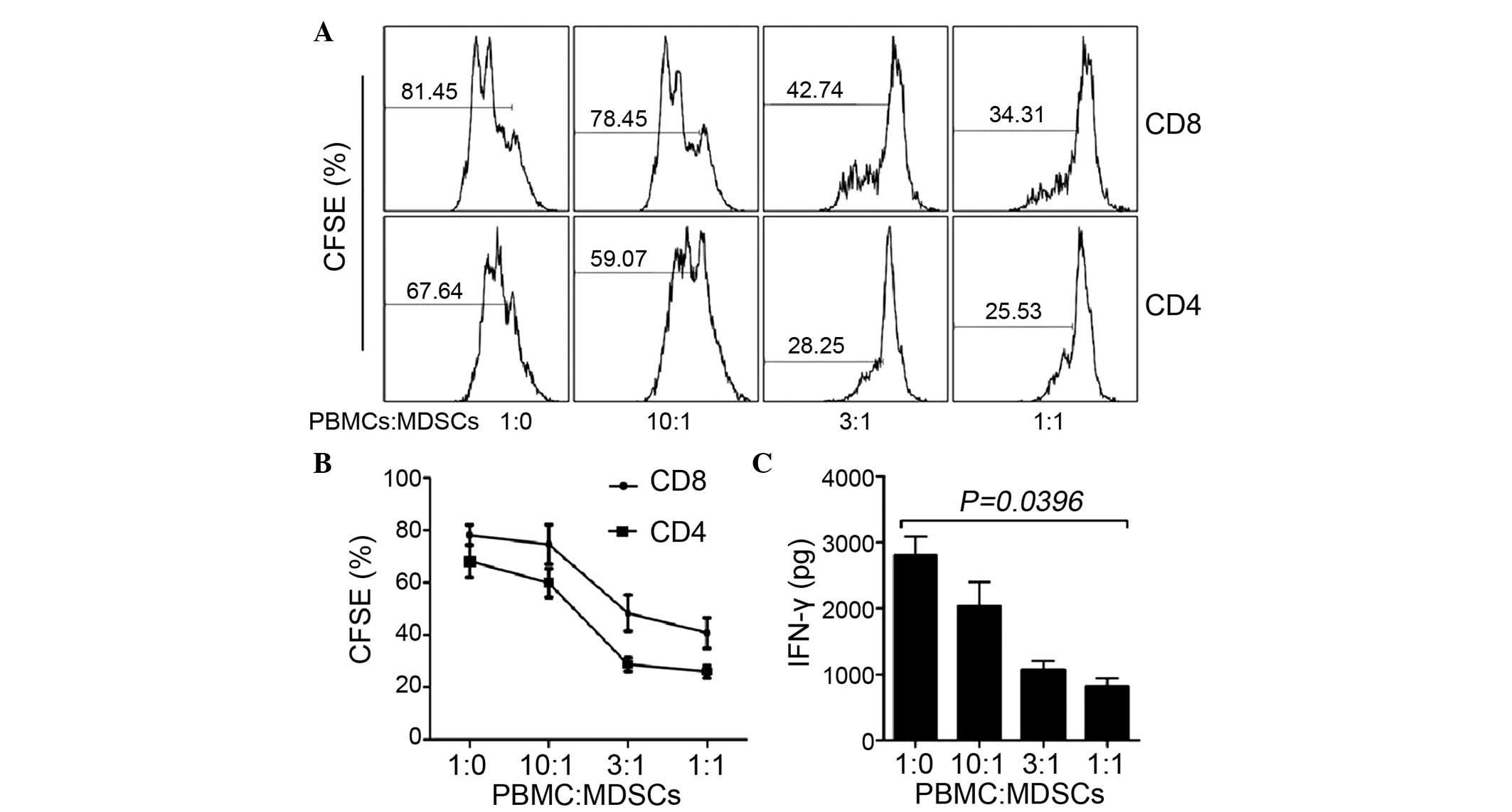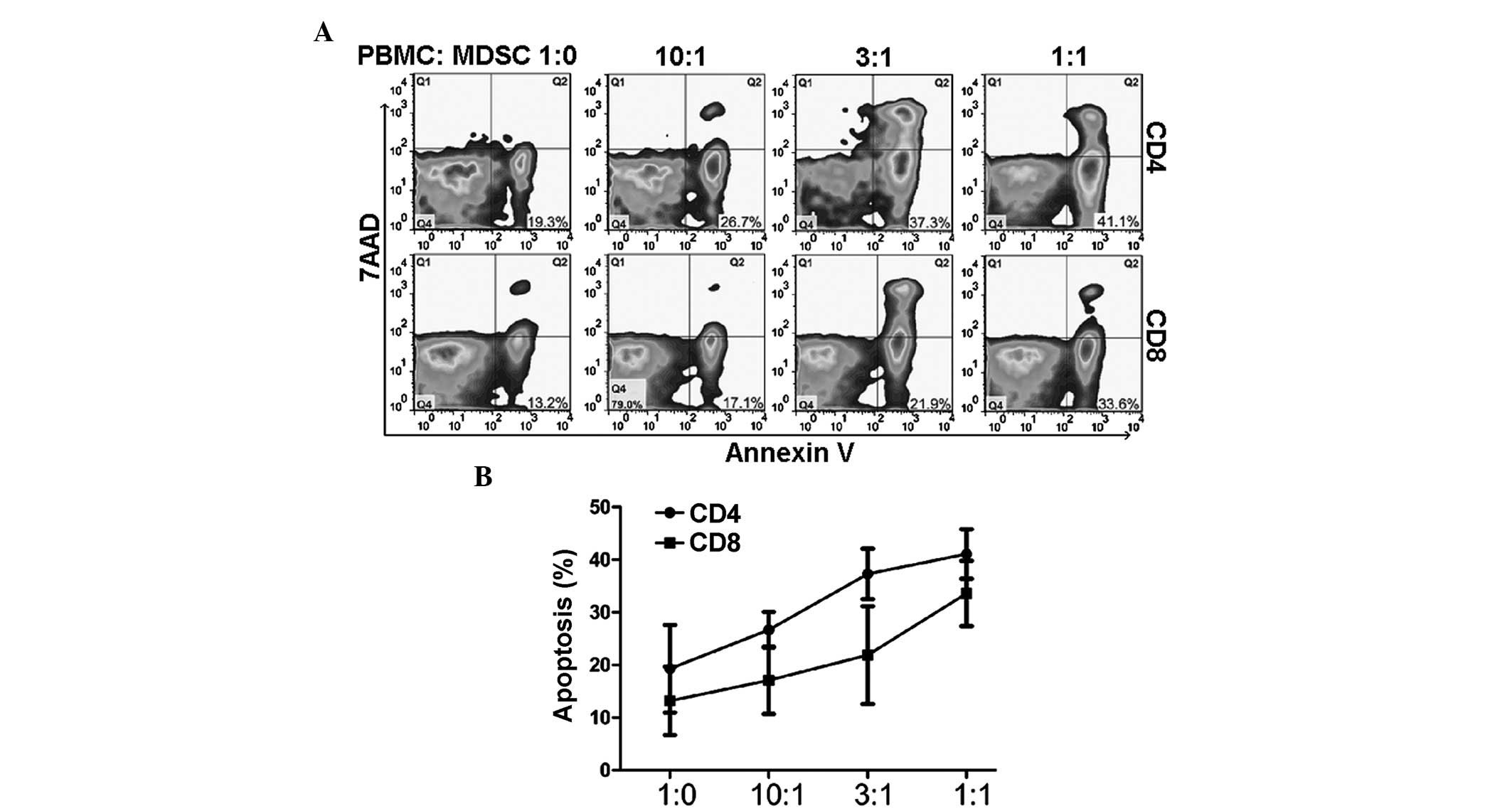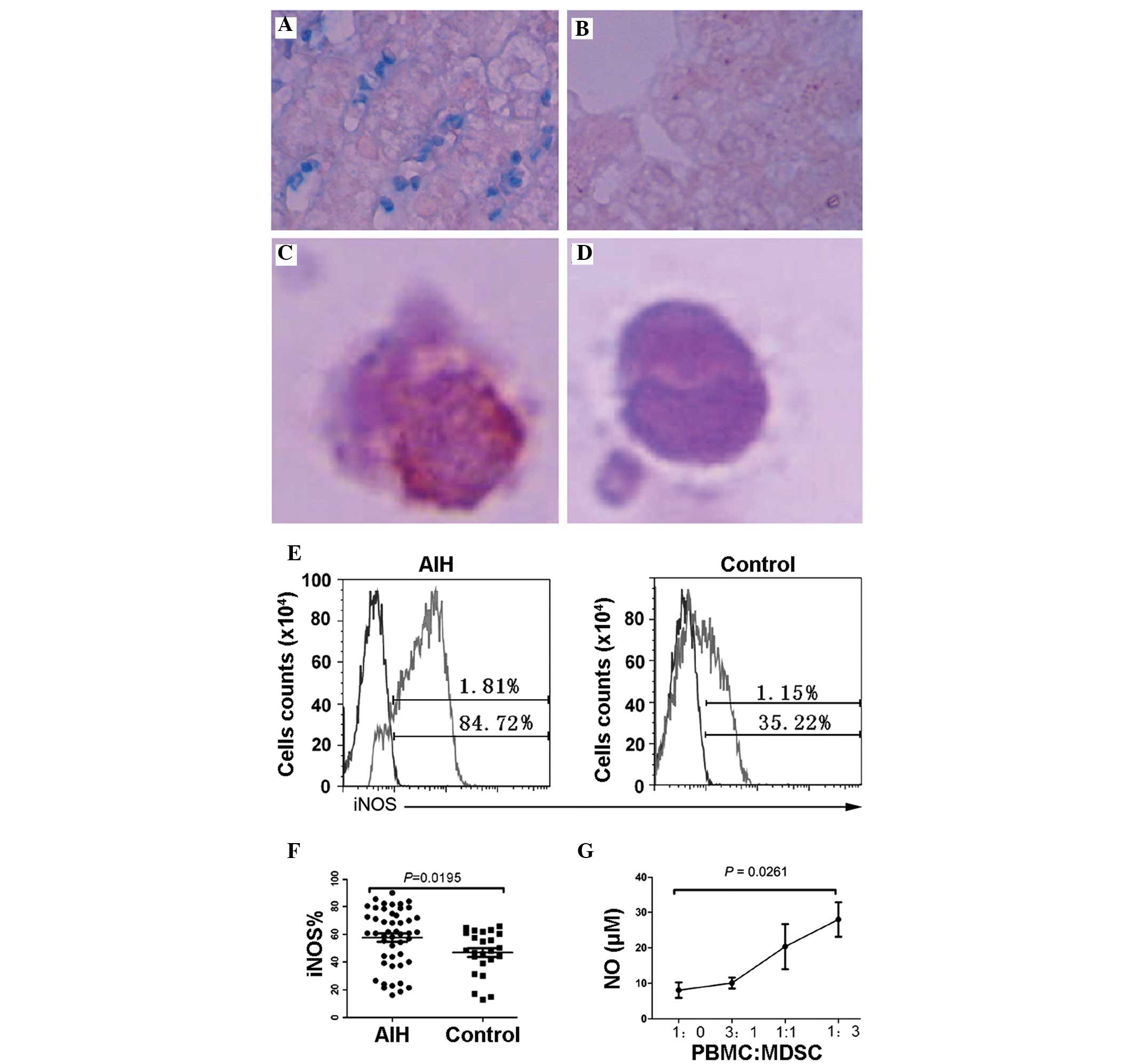Myeloid-derived suppressor cells suppress CD4+ and CD8+ T cell responses in autoimmune hepatitis
- Authors:
- Published online on: May 15, 2015 https://doi.org/10.3892/mmr.2015.3791
- Pages: 3667-3673
Abstract
Introduction
Autoimmune hepatitis (AIH) is a type of chronic, autoimmune inflammation of the liver, which is characterized by histological interface hepatitis, hypergammaglobulinemia and the production of autoantibodies (1). During AIH, the self-tolerance, also termed homeostatic processes, is defective, resulting in dysfunction of T-lymphocytes, including over-activated CD4 and CD8 T-cells, which mediate autoimmune liver injury (2). Previous evidence has indicated that immune regulatory cells, including regulatory T-cells (3) and natural killer T cells (4) are critical for the maintenance of immune tolerance in AIH. Another subset of regulatory cells, termed myeloid-derived suppressor cells (MDSCs) have identified to possess a marked ability to suppress T-cell responses, therefore, representing an attractive candidate for immune intervention to reconstitute self-tolerance in autoimmune conditions (5).
MDSCs are a heterogeneous population of immature myeloid cells, derived from dendritic cell (DC) progenitors, macrophages and granulocytes in cancer, inflammation and autoimmune disease, which have been defined as CD11b (Mac-1) and Gr-1 for granulocytic MDSCs and CD11b, Gr-1, CD115 and F4/80 for monocytic MDSCs (6). These exist in an activated state, which is characterized by the increased production of reactive oxygen species (ROS), reactive nitrogen species (RNS) and arginase-1. They are potent suppressors of T-cell functions, using arginase-1 and inducible nitric oxide synthase (iNOS) (7). In humans, the identification of MDSCs is indistinct due to the absence of specific markers therefore, their phenotype is established, according to their functional definition (8). Generation and accumulation of MDSCs in peripheral blood and regional tissues in response to tumor, infection or trauma is associated with multiple growth factors and cytokines, including granulocyte macrophage colony-stimulating factor, vascular endothelial growth factor, interleukin (IL)-1β, IL-6, stem cell factor, cyclooxygenase-2 (prostaglandin-endoperoxide synthase 2), interferon (IFN)-γ, IL-4, IL-13 and transforming growth factor (TGF)-β, which induce MDSCs generation and promoted MDSCs activation (9).
In autoimmune diseases, including inflammatory bowel disease, experimental autoimmune encephalomyelitis and experimental autoimmune uveoretinitis, the frequency of human MDSCs with suppressive function are increased in peripheral blood from patients and rodents, which suggests a novel MDSC-mediated immune regulatory pathway in autoimmune diseases (10). The characterization of MDSCs during AIH remains to be elucidated. The present study investigated the frequency and function of MDSCs in AIH, and further analyzed the clinical relevance of MDSC frequency with disease status in patients with AIH.
Subjects and methods
Subjects and healthy donors
A total of 48 peripheral blood and three liver samples were obtained from patients with AIH between October 2009 and October 2010 at The Third Affiliated Hospital of Anhui Medical University (Hefei, China). AIH was diagnosed, according to the International Autoimmune Hepatitis Group diagnostic scoring system in 1999 (total score >17) (11). A number of the patients were diagnosed, according to pathology (Table I). None of the patients received treatment with glucocorticoids or immunosuppres-sants, and 15 patients with AIH were treated with Prednisone for 6 months. Prednisone alone was used to achieve a clinical remission, at an initial dose of 40 mg/day for 4 weeks, followed by 10 mg/day for maintenance. In addition, 24 peripheral blood samples and two liver tissue samples were obtained from healthy individuals, as a normal control. Tissue samples were obtained by liver biopsy. No statistically significant differences were observed between the two groups in age or gender ratio (P>0.05). The present study was approved by the Ethics Committee of The Third Affiliated Hospital of Anhui Medical University, and written informed consent was obtained from each subject. Table I shows the clinical characteristics of the patients with AIH, who were involved in the present study.
Antibodies
Fluorescein isothiocyanate (FITC)-conjugated Lin1 (cat. no. 340546; 20 µl), mouse anti-human leukocyte antigen (HLA)-DR, peridin chlorophyl protein (PerCP)-conjugated mouse anti-HLA-DR (cat. no. 552764; 20 µl), mouse anti-CD8 (cat. no. 561967; dilution, 0.2 mg/ml), allophycocyanin (APC)-conjugated mouse anti-CD11b (cat. no. 553312; dilution, 0.2 mg/ml), anti-CD3 and mouse anti-CD4 (cat. no. 340443; dilution, 6 µg/ml) and mouse phycoerthrin (PE)-conjugated anti-CD33 (cat. no. 555450; 20 µl) antibodies were purchased from Becton Dickinson (San Diego, CA, USA). Mouse anti-CD3 (cat. no. SAB4700040; dilution, 1 mg/ml) and mouse anti-CD28 (cat. no. SAB4700739; dilution, 1 mg/ml) monoclonal antibodies were purchased from Sigma-Aldrich (St. Louis, MO, USA).
Flow cytometric analysis
Cell surface staining was performed, according to established methods (12). A total of 1–3×105 cells/condition were incubated for 30 min at 4°C with different combinations of the following antibodies: (FITC)-Lin1 (20 µl/test), (PerCP)-HLA-DR (20 µl/test), (APC)-CD11b (10 µl/test) and (PE)-CD33 (20 µl/test). Following two washes with 1 ml phosphate buffered saline (PBS), the cells were resuspended in 100 µl 1% paraformalde-hyde (Beijing Ding Guo Chang Sheng Biotechnology Co., Ltd., Beijing, China) and analyzed using a FACSCalibur (Becton Dickinson). The data were analyzed using FlowJo v.5.7.2 software (Tree Star, Ashland, Oregon, USA).
Cell isolation and sorting
Peripheral blood mononuclear cells (PBMCs) were isolated using Ficoll-Hypaque density gradient centrifugation (IAE-1) at 2,700 x g for 20 min at 22°C from heparinized blood. The Lin1-/low HLA-DR- CD33+ CD11b+ MDSCs were isolated from the PBMCs using Lin1 and HLA-DR negative selection (Miltenyi Biotech, Bergisch Gladbach, Germany), followed by analysis using a BD FACS Aria (Becton Dickinson). The purity of the MDSCs was >85%. The CD3+ T cells were separated from the PBMCs via CD3-positive selection using a MidiMACS separator unit, according to the manufacturer's instructions (Miltenyi Biotech,). The purity of the CD3+ T cells was >96%.
Proliferation assay and the detection of cytokines
Carboxylfluorescein succinimidyl ester (CFSE) labeling was used to detect the proliferation of CD3+ T cells. Briefly, 1.3×106 CD3+ T cells were co-cultured with MDSCs at ratios of 1:0, 1:1, 3:1 and 10:1 in RPMI-1640 medium, supplemented with 10% fetal bovine serum (FBS; Gibco Life Technologies, Carlsbad, CA, USA) and stimulated with anti-CD3 and CD28 monoclonal antibodies (Sigma-Aldrich). All CD3+ T cells were seeded into a 96-well plate (Costar, Lowell, MA, USA) in the presence or absence of MDSCs, as mentioned above. The cells were harvested following culturing for 5 days and stained with anti-CD4-APC and anti-CD8-PerCp. As the CFSE signal was diluted with each cell division, cells exhibiting low fluorescence intensity of CFSE were considered to have proliferated. IFN-γ in the supernatant was measured using an ELISA kit (RapidBio Laboratory, Calabasas, CA, USA), according to the manufacturer's instructions.
Apoptosis assay
The CD3+ T cells were co-cultured with MDSCs at the ratios mentioned above and treated with anti-CD3 and CD28 monoclonal antibodies. Following incubation for 48 h, the cells were collected and stained with annexin-V-FITC, 7-amino-actinomycin D (7-AAD) (eBioscience, San Diego, CA, USA), anti-CD4-APC and anti-CD8-PerCp to analyze the apoptosis of the CD4 and CD8 cells.
Expression of iNOS and determination of NO
To confirm the suppression of MDSCs, iNOS were first detected on the surface of MDSCs from the patients and healthy subjects using anti-iNOS (Santa Cruz Biotechnology, Inc., Santa Cruz, CA, USA). The NO content of the supernatant was subsequently determined using an ELISA kit (Rapidbio Lab, CA). Immunohistochemistry was also performed to detect the expression levels of iNOS in the liver tissues and MDSCs. The expression of iNOS was detected using a rabbit-anti-iNOS antibody (cat. no. ab92765; Abcam, Cambridge, UK) in lymphocyte markers on the liver tissue and PBMCs were detected using an immunohistochemical kit (Zhongshan Golden Bridge Co., Beijing, China).
Statistical analysis
All statistical analyses were performed using SPSS 13.0 software for Windows (SPSS, Inc., Chicago, IL, USA). Comparisons between different groups were analyzed using a Mann-Whitney U test. A Wilcoxon matched-pairs signed ranks test was used to compare the data from the same individuals. Correlation analysis was performed using the Spearman rank correlation test. All data are presented as the mean ± standard deviation. P<0.05 was considered to indicate a statistically significant difference.
Results
Increased frequency of MDSCs (Lin1−/low HLA-DR− CD33+ CD11b+) in peripheral blood from patients with AIH
Due to the heterogeneity of MDSCs in humans, mature lymphocytes and HLA-DR+ groups were excluded from the present study, with CD33+ was reserved as a myeloid marker and CD11b as its functional marker. Accordingly, MDSCs were defined as the population of CD33+ CD11b+ Lin1− HLA-DR− (Fig. 1A) cells. The MDSCs frequency in PBMCs was determined in samples from patients diagnosed with AIH without cirrhosis, AIH with cirrhosis, and healthy subjects. There was a significantly higher frequency of circulating MDSCs in the AIH patients without cirrhosis compared with the AIH patients with cirrhosis and the healthy subjects (P=0.012). No significant difference was observed between the healthy subjects and the AIH patients with cirrhosis (Fig. 1B; PControl:AIH<0.001, PAIH:Cirrhosis<0.001).
Frequency of MDSCs in the peripheral blood correlates with clinical features
A significant positive correlation was observed between the MDSC frequency and the levels of ALT/AST (Fig. 1C), which suggested that the frequency of MDSCs was associated with liver inflammation. However, other clinical indicators, including total bilirubin, direct bilirubin, cholinesterase, alkaline phosphatase, immuno-globulin G and prealbumin, revealed no correlation with the frequency of MDSCs (P>0.05). In order to determine the effect of hormones on the frequency of MDSCs, 15 patients receiving hormone therapy were included. After 6 months of treatment, the majority of these patients were in remission, accompanied with a reduced frequency of MDSCs (Fig. 1D; P=0.0017).
MDSCs inhibit the proliferation of T cells in vitro
To investigate the effects of MDSC on T cells, MDSCs were sorted and subsequently co-cultured with CFSE-labeled CD3+ T cells at different ratios. Following culture for 5 days, the proliferation of the CD4 and CD8 T cells were detected using flow cytometry. As the cell density of the MDSCs increased, the proliferation of CD4 and CD8 T cells was inhibited (Fig. 2A and B). In addition, the present study examined the capacity of MDSCs to inhibit cytokine secretion. An ELISA was performed to detect IFN-γ in the culture supernatant. The results demonstrated that the concentration of IFN-γ decreased with the increase in MDSCs (Fig. 2C; PALT=0.047, PAST=0.051), which suggested that the MDSCs inhibited cytokine secretion in a dose-dependent manner.
MDSCs promote T cell apoptosis in vitro
Apoptosis detection was performed using annexin V and 7AAD staining. (Fig. 3). The sorted MDSCs were cocultured with PBMC, and the apoptosis of CD4 and CD8 T cells was detected. The results revealed that MDSCs promoted CD4+ and CD8+ T cell apoptosis in a dose-dependent manner (Fig. 3; P=0.018).
Expression of iNOS in MDSCs
The present study subsequently examined the in situ expression of iNOS by lymphocytes in the liver. The expression of iNOS in the lymphocytes of the AIH liver tissue was significantly higher, compared with the healthy liver tissue (Fig. 4A and B). In addition, MDSCs from the peripheral blood were sorted and stained with iNOS monoclonal antibody, which demonstrated that the expression level of iNOS in the MDSCs was significantly higher than in the other PBMCs. (Fig. 4C and D). The PBMCs from 48 patients and 24 healthy individuals were stained and analyzed. The expression of iNOS in the circulating MDSCs from patients with AIH was significantly higher than in the healthy individuals (Fig. 4E and F; P=0.0195). Correspondingly, the concentrations of NO in the supernatant, detected using ELISA, were also associated with the frequency of MDSCs (Fig. 4G; P=0.0261).
Discussion
MDSCs are essential in regulating immune responses during autoimmune diseases. The present study demonstrated for the first time, to the best of our knowledge, the frequency and function of MDSCs from patients with AIH. The results demonstrated that increased frequencies of peripheral blood MDSCs were associated with liver injury. Hormone therapy reduced the frequency of peripheral blood MDSCs in patients with AIH. MDSCs from patients with AIH suppressed the proliferation and cytokine secretion of T cells. In addition, MDSC promoted the apoptosis of T cells in a dose-dependent manner in vitro. Notably, higher expression levels of iNOS in the MDSCs were observed in the in situ liver tissues from patients with AIH, compared with the healthy subjects. Additionally, peripheral blood MDSCs expressed iNOS and produced NO.
As precursors of macrophages, granulocytes and dendritic cells, MDSCs are heterogeneous, immature and plastic. In humans, MDSCs remains to be fully characterized owing to the lack of specific markers (13). Generally, human MDSCs are identified as CD14−CD11b+ cells, or populations of cells expressing the myeloid-associated marker, CD33, but not the MHC Class II molecules, HLA-DR, mature myeloid or lymphoid cell markers (14). In addition, a group of CD15+ MDSCs have been identified in the peripheral blood of patients with cancer (15). A previous study characterized a novel population of MDSCs, which were CD14+ and HLA-DR−/low. They are significantly increased in the peripheral blood and tumor tissues of patients with hepatocellular carcinoma, exhibit arginase activity and suppress autologous T cell proliferation (16). The present study used Lin1−/low HLA-DR-CD33+ CD11b+ as markers of human peripheral blood MDSCs, and investigated the frequency of MDSCs in the peripheral blood of patients with AIH. The results demonstrated an increased frequency of peripheral blood MDSCs, which reduced following hormone treatment, suggesting that MDSCs are essential during the progression and treatment of AIH.
It has been reported that the immunosuppressive activities of MDSCs require direct cell-cell contact, which is through cell-surface receptors and soluble mediators, and the suppressive activity of MDSCs is associated with the metabolism of arginine and iNOS (17). Another important factor contributing to the suppressive activity of MDSCs is ROS (18). Increased production of ROS has emerged as one of the predominant characteristics of MDSCs from tumor-bearing mice and patients with cancer (19). NO, produced by iNOS, is also involved in the suppressive activity of MDSCs (20). A previous study also demonstrated that peroxynitrite is a crucial mediator of the suppression of T-cell function by MDSCs (21). Notably, a novel population of MDSCs, described as CD14+ DR−/low, have been demonstrated to promote the de novo development of forkhead box P3+ regulatory T cells in vivo. In addition, MDSCs secrete immunosuppressive cytokines, including TGF-β and IL-10, to inhibit T cell function (22). The present study demonstrated higher expression levels of iNOS in the peripheral blood MDSCs and also in in situ liver tissues from patients with AIH. In vitro experiments revealed that MDSCs suppressed the function of T cells by inhibiting proliferation and the cytokine secretion of T cells, and by promoting apoptosis of the T cells.
MDSC expansion is associated with inflammation and autoimmunity. In experimental autoimmune encephalomyelitis, a mouse model of multiple sclerosis, the number of MDSCs has been observed to increase in the spleen and blood (23). A significant increase in the number of MDSCs has also been detected in experimental autoimmune uveoretinitis and in inflammatory bowel diseases (24). In mouse models of systemic lupus erythematosus, alopecia areata and type 1 diabetes, MDSCs demonstrate increased frequency and immune suppression (25). The present study revealed for the first time, to the best of our knowledge, that the frequency of peripheral blood MDSCs in patients with AIH was increased, which was consistent with the mouse models of autoimmune disease.
Previous studies have demonstrated that activated CD4+ and CD8+ T cells induce autoimmune liver injury through antibody-dependent cell-mediated cytotoxicity and the cytotoxic T lymphocyte (CTL) killing effect. Th1 cells cytokines, including IFN-γ, IFN-α, IL-1 and IL-2, together with T helper 2 cell cytokines, including IL-4, IL-6, IL-10, IL13, IL-17 and TGF-β, are also induced during the pathology of liver injury (26). The activation, recruitment and amplification of MDSCs is closely associated with the stimulation of inflammatory cytokines (27), among which IFN-γ, IL-6, IL-10, IL-13 and TGF-β stimulate MDSCs recruitment and amplification, and IFN-γ, IL-4, IL-13, IL-17 and TGF-β induce MDSC activation (28). Therefore, the present study hypothesized that MDSCs present a compensatory mechanism against inflammation. The present study demonstrated that the level of MDSCs were higher during the severe inflammatory reaction stage, and the increase in MDSCs was positively correlated with ALT and AST, which suggested that MDSCs correlated with the level of liver inflammation. By contrast, during the cirrhosis period of AIH, the frequency of MDSCs declined. This weakened suppression of MDSCs exacerbated the liver injury.
MDSC are involved in the immune response, not only in inflammation associated with cancer, but also in autoimmune disease, including AIH. The present study investigated the frequency and function of peripheral blood MDSCs from patients with AIH. The increased frequency of circulating MDSCs in patients with AIH was associated with liver injury, and effective hormone treatment reduced the frequency of MDSCs. In addition, higher expression levels of iNOS were observed in the in situ liver tissues of patients with AIH. This characterization of MDSCs improves current understanding of the pathogenesis of AIH and may provide a possible method of immune intervention.
Acknowledgments
This study was supported by the Hefei Science and Technology Development Special Fund (no. 201154-19-2) and the Hefei Science and Technology Program (no. 2013183-29).
References
|
Manns MP and Vogel A: Autoimmune hepatitis, from mechanisms to therapy. Hepatology. 43(Suppl 2): 132–144. 2006. View Article : Google Scholar | |
|
Longhi MS, Ma Y, Mieli Vergani G and Vergani D: Aetiopathogenesis of autoimmune hepatitis. J autoimmun. 34:7–14. 2010. View Article : Google Scholar | |
|
Longhi MS, Meda F, Wang P, Samyn M, Mieli-Vergani G, Vergani D and Ma Y: Expansion and de novo generation of potentially therapeutic regulatory T cells in patients with autoimmune hepatitis. Hepatology. 47:581–591. 2008. View Article : Google Scholar : PubMed/NCBI | |
|
Kawamura H, Aswad F, Minagawa M, Govindarajan S and Dennert G: P2X7 receptors regulate NKT cells in autoimmune hepatitis. J Immunol. 176:2152–2160. 2006. View Article : Google Scholar : PubMed/NCBI | |
|
Gabrilovich DI and Nagaraj S: Myeloid-derived suppressor cells as regulators of the immune system. Nat Rev Immunol. 9:162–174. 2009. View Article : Google Scholar : PubMed/NCBI | |
|
Peranzoni E, Zilio S, Marigo I, Dolcetti L, Zanovello P, Mandruzzato S and Bronte V: Myeloid-derived suppressor cell heterogeneity and subset definition. Curr Opin Immunol. 22:238–244. 2010. View Article : Google Scholar : PubMed/NCBI | |
|
Solito S, Falisi E, Diaz-Montero CM, Doni A, et al: A human promyelocytic-like population is responsible for the immune suppression mediated by myeloid-derived suppressor cells. Blood. 118:2254–2265. 2011. View Article : Google Scholar : PubMed/NCBI | |
|
Haile LA, von Wasielewski R, Gamrekelashvili J, Krüger C, Bachmann O, Westendorf AM, et al: Myeloid-derived suppressor cells in inflammatory bowel disease: a new immunoregulatory pathway. Gastroenterology. 135:871–881. 881e1–e5. 2008. View Article : Google Scholar : PubMed/NCBI | |
|
Goh C, Narayanan S and Hahn YS: Myeloid-derived suppressor cells: the dark knight or the joker in viral infections? Immunol Rev. 255:210–221. 2013. View Article : Google Scholar : PubMed/NCBI | |
|
Ugel S, Delpozzo F, Desantis G, Papalini F, Simonato F, Sonda N, et al: Therapeutic targeting of myeloid-derived suppressor cells. Curr Opin Pharmacol. 9:470–481. 2009. View Article : Google Scholar : PubMed/NCBI | |
|
Manns MP, Czaja AJ, Gorham JD, Krawitt EL, Mieli-Vergani G, Vergani D and Vierling JM: Diagnosis and management of autoimmune hepatitis. Hepatology. 51:2193–2213. 2010. View Article : Google Scholar : PubMed/NCBI | |
|
Monu NR and Frey AB: Myeloid-derived suppressor cells and anti-tumor T cells: A complex relationship. Immunol Invest. 41:595–613. 2012. View Article : Google Scholar : PubMed/NCBI | |
|
Highfill SL, Rodriguez PC, Zhou Q, Goetz CA, et al: Bone marrow myeloid-derived suppressor cells (MDSCs) inhibit graft-versus-host disease (GVHD) via an arginase-1-dependent mechanism that is up-regulated by interleukin-13. Blood. 116:5738–5747. 2010. View Article : Google Scholar : PubMed/NCBI | |
|
Lechner MG, Megiel C, Russell SM, Bingham B, Arger N, Woo T and Epstein AL: Functional characterization of human Cd33+ and Cd11b+ myeloid-derived suppressor cell subsets induced from peripheral blood mononuclear cells co-cultured with a diverse set of human tumor cell lines. J Transl Med. 9:902011. View Article : Google Scholar : PubMed/NCBI | |
|
Goedegebuure P, Mitchem JB, Porembka MR, Tan MC, Belt BA, Wang-Gillam A, et al: Myeloid-derived suppressor cells: general characteristics and relevance to clinical management of pancreatic cancer. Curr Cancer Drug Targets. 11:734–751. 2011. View Article : Google Scholar : PubMed/NCBI | |
|
Hoechst B, Ormandy LA, Ballmaier M, Lehner F, Krüger C, Manns MP, et al: A new population of myeloid-derived suppressor cells in hepatocellular carcinoma patients induces CD4(+)CD25(+)Foxp3(+) T cells. Gastroenterology. 135:234–243. 2008. View Article : Google Scholar : PubMed/NCBI | |
|
Liu CY, Wang YM, Wang CL, Feng PH, Ko HW, Liu YH, et al: Population alterations of L-arginase- and inducible nitric oxide synthase-expressed CD11b+/CD14 (-)/CD15+/CD33+ myeloid-derived suppressor cells and CD8+ T lymphocytes in patients with advanced-stage non-small cell lung cancer. J Cancer Res Clin Oncol. 136:35–45. 2010. View Article : Google Scholar | |
|
Jayaraman P, Parikh F, Lopez-Rivera E, Hailemichael Y, Clark A, Ma G, et al: Tumor-expressed inducible nitric oxide synthase controls induction of functional myeloid-derived suppressor cells through modulation of vascular endothelial growth factor release. J Immunol. 188:5365–5376. 2012. View Article : Google Scholar : PubMed/NCBI | |
|
Raber PL, Thevenot P, Sierra R, et al: Subpopulations of myeloid-derived suppressor cells impair T cell responses through independent nitric oxide-related pathways. Int J Cancer. 134:2853–2864. 2014. View Article : Google Scholar : | |
|
Jia W, Jackson-Cook C and Graf MR: Tumor-infiltrating, myeloid-derived suppressor cells inhibit T cell activity by nitric oxide production in an intracranial rat glioma+vaccination model. J Neuroimmunol. 223:20–30. 2010. View Article : Google Scholar : PubMed/NCBI | |
|
Lu T, Ramakrishnan R, Altiok S, Youn JI, Cheng P, Celis E, et al: Tumor-infiltrating myeloid cells induce tumor cell resistance to cytotoxic T cells in mice. J Clin Invest. 121:4015–4029. 2011. View Article : Google Scholar : PubMed/NCBI | |
|
Lechner MG, Liebertz DJ and Epstein AL: Characterization of cytokine-induced myeloid-derived suppressor cells from normal human peripheral blood mononuclear cells. J Immunol. 185:2273–2284. 2010. View Article : Google Scholar : PubMed/NCBI | |
|
Ioannou M, Alissafi T, Lazaridis I, Deraos G, Matsoukas J, Gravanis A, et al: Crucial role of granulocytic myeloid-derived suppressor cells in the regulation of central nervous system autoimmune disease. J Immunol. 188:1136–1146. 2012. View Article : Google Scholar : PubMed/NCBI | |
|
Kerr EC, Raveney BJ, Copland DA, Dick AD and Nicholson LB: Analysis of retinal cellular infiltrate in experimental autoimmune uveoretinitis reveals multiple regulatory cell populations. J Autoimmun. 31:354–361. 2008. View Article : Google Scholar : PubMed/NCBI | |
|
Yin B, Ma G, Yen CY, Zhou Z, Wang GX, Divino CM, et al: Myeloid-derived suppressor cells prevent type 1 diabetes in murine models. J Immunol. 185:5828–5834. 2010. View Article : Google Scholar : PubMed/NCBI | |
|
Carambia A and Herkel J: CD4 T cells in hepatic immune tolerance. J Autoimmun. 34:23–28. 2010. View Article : Google Scholar | |
|
Ribechini E, Greifenberg V, Sandwick S and Lutz MB: Subsets, expansion and activation of myeloid-derived suppressor cells. Med Microbiol Immunol. 199:273–281. 2010. View Article : Google Scholar : PubMed/NCBI | |
|
He D, Li H, Yusuf N, Elmets CA, Li J, Mountz JD and Xu H: IL-17 promotes tumor development through the induction of tumor promoting microenvironments at tumor sites and myeloid-derived suppressor cells. J Immunol. 184:2281–2288. 2010. View Article : Google Scholar : PubMed/NCBI |













